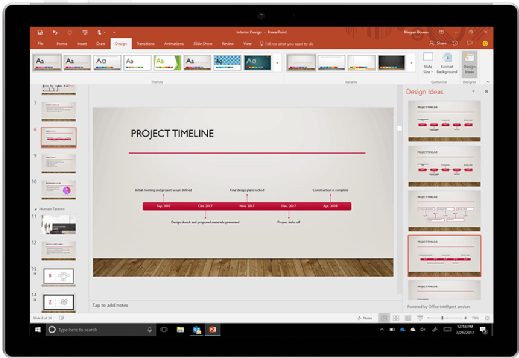presentation software
What is presentation software?
Presentation software, also known as graphics presentation applications or presentation graphics programs, is a category of software used to create content where information is often represented in a graphical or visual way. A variety of presentation software is available to help tell a story or support written information using pictures, charts, graphs and other visual elements.
Types of presentation software
There are two main types of presentation software: business presentation software and general multimedia authoring tools.
Business presentation software products generally emphasize ease of learning and use, particularly for nontechnical and business users. However, they can include more advanced functions for experienced users. Most business presentation applications let users include visual elements like images, and sometimes audio and video.
General multimedia authoring software lets users create sophisticated presentations that might include photos, icons, audio narrations, transitions, animations and video sequences. Some presentations products combine ease of use and sophisticated features.
Key features in presentation software
Presentation software often includes templates to create visually rich presentations and slide decks. Templates can be easily edited to match user requirements or company brand guidelines. The software usually includes a search feature to discover these templates, as well as approved layouts and previous presentations.
Cloud-based presentation applications generally include shared workspaces and team folders that let multiple people securely collaborate, provide inputs, set status updates, and add comments and reactions. Users can also share presentations, project plans, conference keynotes, sales decks and more in real time. Versioning capabilities might be included so authorized users can manage version history, recover previous versions and view current progress.
Many vendors offer a centralized library of images, photos, icons and animations, and regularly update these libraries so customers can access the visual elements for their presentations. Some applications also integrate with external image sources like Unsplash, Giphy and Brandfetch, so business users can find additional digital assets such as images, logos, fonts and colors.
Other vendors' presentation software integrates with external video sites like YouTube or Vimeo, enabling users to embed video to support the deck's story or main message. Still other graphics applications include audio and data capabilities so users can add narrations to content and integrate data from Google Analytics, Google Sheets and other sources to accompany and strengthen the text.
Some applications include a built-in designer that implements predefined design rules and guardrails. Once content is added to the software, the designer converts notes, data and more into visually rich slides. The slides automatically adapt to the rules, so users don't have to make manual adjustments to change text font and resize images, for example. In addition, the software might include intuitive editing options and smart formatting capabilities to let users make quick edits and finalize a presentation.
The best presentation software includes support for brand esthetics. The application updates every slide and deck with the brand's specific fonts, colors, logos, themes and templates to create consistent brand presentations with the approved brand style. In most cases, style themes are customizable so company logos, colors, fonts and icon styles can be added to the presentation theme and updated as needed.

Artificial intelligence in presentation software
Presentation software products have evolved with more advanced capabilities and intuitive options for edits, sharing and collaboration. Sophisticated applications also include conversational AI engines so users can automatically generate new presentations quickly.
Depending on the software's capabilities, the AI engine may create the first draft of the presentation based on a user's description and needs.
Some AI-powered presentation products include smart templates that can quickly edit the autogenerated software and adapt the content to a user's or brand's story. The application might also include a designer bot that takes design inputs from the (human) user in natural language and generates unique images.
Common applications of presentation software
Presentation software is especially useful to create presentations and decks that include some combination of text, animations, images, video, audio and transitions. These might include creative briefs, pitch decks, moodboards, competitor analyses, proposals, bulletins, project reports, annual reviews, marketing plans and meeting discussions.
All these presentations can be displayed in a slideshow format. Built-in templates, content libraries and editing tools accelerate the design process, regardless of the presentation's purpose or intended audience.
Popular presentation software products
Microsoft PowerPoint is one of the most popular presentation software applications available today. It includes numerous user-friendly features for design, sharing and collaboration, object insertion, slideshows, text formatting, audio and video.
Other popular products include Lotus Freelance Graphics, Google Slides, Prezi, Slidebean, Canva and Keynote. Most of these products offer PC and Mac versions. In addition, many are free to download and use, while others come in free, paid or freemium versions.
Presentation software might include different features and capabilities. Organizations and users must assess their requirements, technical stack, audience type and budget before making a purchase.
For example, a geographically dispersed team might be better suited to a cloud-based application that supports borderless collaboration than a desktop application that can't be accessed from outside the enterprise network. Similarly, a marketing plan might require more visual elements while an investor update might require more graphs or charts. The software that is ultimately selected should satisfy these specific requirements.
For more on this topic, learn how to create a successful presentation.
